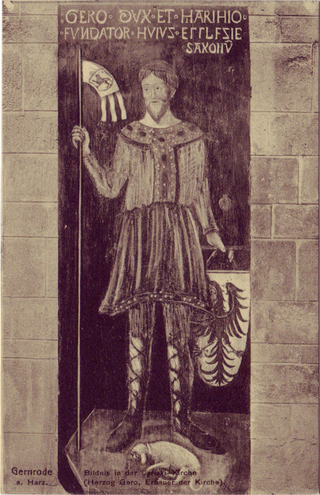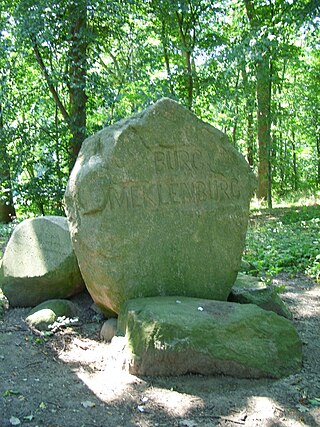External links
- König Kruto (in German)
Kruto the Wend (or Cruto) (died 1093), son of Grin or Grinus, was a prince of Wagria. [1] James Westfall Thompson believed his family belonged to the Rani of Rugia.
Gottschalk, a Christian Obodrite prince who was married to the daughter of his Danish ally Sven Estridson, had subdued the Obodrite and some Lutician tribes in the 1050s. [2] In 1066, Kruto succeeded in an uprising initiated by the Obodrite nobility and supported by the Luticians, against Gottschalk and his Saxon dukes Ordulf and Magnus. [3] Gottschalk was slain, and his sons Budivoj and Henry exiled to Saxony and Denmark. [2] Kruto made his capital out of a large palisaded fortress at Buku, an island in the confluence of the Trave and Wakenitz rivers and site of the later Lübeck.
In 1074 or 1075, Budivoj, a son of Gottschalk, with a band of Holsteiners sent by Magnus, attacked Kruto's stronghold at Plön, [3] which had been purposefully left undefended. The next day, it was surrounded by Slavic forces, who made the Saxons surrender, after which they were massacred. Budivoj was killed. [3]
Until his death in 1093, Nordalbingia, including Holstein, Sturmaria, and Ditmarsch, was subject to his pagan rule. For decades, Magnus, Eric of Denmark, and the margraves of the Northern March (Udo II, Henry I, and Udo III) struggled to subdue Kruto, but only Eric came close.
Kruto's principality was weak internally, however, because the vassal Slavs, such as the Liutizi, continued to elect their own chiefs subordinate to him. As well, the Christian Obodrites were secretly allied with the Saxons to bring about his downfall. At a banquet at which Kruto intended to kill Gottschalk's son Henry, his guest, Henry and Kruto's wife Slavina instead killed him. Immediately after his death, Henry, a Christian Obodrite prince, led a combined Slav-Saxon army to victory over the Wends at the Battle of Schmilau and subjected the Wagri and Liutizi to tribute again.

The Obotrites or Obodrites, also spelled Abodrites, were a confederation of medieval West Slavic tribes within the territory of modern Mecklenburg and Holstein in northern Germany. For decades, they were allies of Charlemagne in his wars against the Germanic Saxons and the Slavic Veleti. The Obotrites under Prince Thrasco defeated the Saxons in the Battle of Bornhöved (798). The still heathen Saxons were dispersed by the emperor, and the part of their former land in Holstein north of Elbe was awarded to the Obotrites in 804, as a reward for their victory. This however was soon reverted through an invasion of the Danes. The Obotrite regnal style was abolished in 1167, when Pribislav was restored to power by Duke Henry the Lion, as Prince of Mecklenburg, thereby founding the German House of Mecklenburg.

The Northern March or North March was created out of the division of the vast Marca Geronis in 965. It initially comprised the northern third of the Marca and was part of the territorial organisation of areas conquered from the Wends. A Lutician rebellion in 983 reversed German control over the region until the establishment of the March of Brandenburg by Albert the Bear in the 12th century.

The Wendish Crusade was a military campaign in 1147, one of the Northern Crusades and a part of the Second Crusade, led primarily by the Kingdom of Germany within the Holy Roman Empire and directed against the Polabian Slavs. The Wends were made up of the Slavic tribes of Abrotrites, Rani, Liutizians, Wagarians, and Pomeranians who lived east of the River Elbe in present-day northeast Germany and Poland.
Saint Gottschalk was a prince of the Obotrite confederacy from 1043 to 1066. He established a Slavic kingdom on the Elbe in the mid-11th century. His object in life seems to have been to collect the scattered tribes of the Slavs into one kingdom, and to make that kingdom Christian.

Polabian Slavs is a collective term applied to a number of Lechitic tribes who lived scattered along the Elbe river in what is today eastern Germany. The approximate territory stretched from the Baltic Sea in the north, the Saale and the Limes Saxoniae in the west, the Ore Mountains and the Western Sudetes in the south, and Poland in the east. They have also been known as Elbe Slavs or Wends. Their name derives from the Slavic po, meaning "by/next to/along", and the Slavic name for the Elbe.

Gero I, sometimes called the Great, was a German nobleman who ruled an initially modest march centred on Merseburg in the south of the present German state of Saxony-Anhalt, which he expanded into a vast territory named after him: the marca Geronis. During the mid-10th century, he was the leader of the Saxon Ostsiedlung.
The Wagri, Wagiri, or Wagrians were a tribe of Polabian Slavs inhabiting Wagria, or eastern Holstein in northern Germany, from the ninth to twelfth centuries. They were a constituent tribe of the Obodrite confederacy.
Henry was an Obotrite prince or king (1093–1127) from the Nakonid dynasty; he was regarded by contemporaries as "King of the Slavs". The Obotrite realm reached its greatest area during Henry's rule, extending from the Elbe to the Oder and from the Havelland to the Baltic Sea.
Budivoj, Buthue, or Butue was the eldest son of Gottschalk, an Obotrite prince, by a mistress. He allied with the dukes of Saxony in order to recover the power and position of his father, lost since Gottschalk's death (1066) to the pagan Kruto.

The Rani or Rujani were a West Slavic tribe based on the island of Rugia (Rügen) and the southwestern mainland across the Strelasund in what is today northeastern Germany.

Niklot or Nyklot was a chief or prince of the Slavic Obotrites and an ancestor of the House of Mecklenburg. He became chief of the Obotrite confederacy, including the Kissini and the Circipani, between the years 1130 and 1131. He remained in this position until his death in 1160. At the same time he was Lord of Schwerin, Quetzin and Malchow. For nearly 30 years he resisted Saxon princes, especially Henry the Lion during the Wendish Crusade.
Ratibor was a prince of the Obotrite confederacy from the Polabian tribe. His capital was Racisburg, which was named in his honor.
The Battle of Schmilau was a battle between a coalition of Christian forces and pagan Slavic Obotrites in 1093.
Pribislav was an Obotrite prince who ruled Wagria as "Lesser king" (regulus) and resided in Liubice, governing one half of the Obotrite lands, the other half being governed by Niklot.

Liubice, also known by the German name Alt-Lübeck, was a medieval West Slavic settlement near the site of modern Lübeck, Germany. Liubice was located at the confluence of the Schwartau with the Trave across from Teerhof Island, approximately four kilometres north of Lübeck's island old town. The residence of Henry, the Christian prince of the Obotrites, Liubice was destroyed after his death by the pagan Rani of Rugia.

Mecklenburg Castle was a medieval castle and a residential capital of the Nakonid and Nikloting dynasties of the Obotrites. It was located just south of the modern village Dorf Mecklenburg, seven kilometres south of the Bay of Wismar in Mecklenburg-Vorpommern, Germany. The only remnants of the ruined castle are parts of an earthen wall. Some scholars have associated Mecklenburg with the medieval trading emporium Reric.
Bucu or Buku is a hill island surrounded by the Trave and Wakenitz Rivers in Lübeck, Germany. It is also the name of a medieval Slavic castle, now ruined, on the island. Count Adolf II of Holstein founded Lübeck on the island in 1143. The Burgkloster, or fortified monastery, of Lübeck is located atop the ruins of Bucu. "Bucu" is also the name of a hill.

Pomerania during the Early Middle Ages covers the History of Pomerania from the 7th to the 11th centuries.
The Kessinians, also known as Kessini, Chizzini, Kcynianie and Chyżanie, were a medieval West Slavic tribe in what is now northeastern Germany. They inhabited the territory between the Warnow and Recknitz rivers, today split between the districts of Rostock and Vorpommern-Rügen in Mecklenburg-Vorpommern. Their capital and name-giving stronghold was a gard near modern Kessin east of Rostock. Linguistically, they belonged to the Polabian Slavs.

The Lutici or Liutizi were a federation of West Slavic Polabian tribes, who between the 10th and 12th centuries lived in what is now northeastern Germany. Four tribes made up the core of the federation: the Redarians, Circipanians (Circipani), Kessinians and Tollensians (Tholenzi). At least in part, the Lutici were a continuation of the Veleti. In contrast to the former and the neighboring peoples, the Lutici were not led by a Christian monarch or duke, rather power was asserted through consensus formed in central assemblies of the social elites, and the Lutici worshipped nature and several deities. The political and religious center was Radgosc.